- marklauren.com
- shauntfitness.com
- LAUREN, Mark - CLARK, Joshua. Body as a gym. Bratislava: Timy partners s.r.o., 2015. 184 p. ISBN 978-80-89311-49-1
Exercise with your own body weight. Can you do it at home?

Exercise anytime, anywhere, anywhere. The only limiting factor is our imagination. That's how to exercise with your own body weight. That's how to train with excellent results. But can it be done at home?
Article content
There are certainly more reasons.
Even professional athletes include this type of training in their program.
Even those individuals who think that it would not bring them the desired results and are constantly and stubbornly using various machines and dumbbells to improve their physique. They too are incorporating several of these exercises into their training.
After all, the results are not directly proportional to the methods used.
We achieve the goal we set for ourselves through our own efforts.
If we want to make progress, it's not enough to just move, but to move with maximum effort. You have to put your whole self into your training. Intensity is important.
And this is probably the only condition that must be fulfilled when exercising with one's own weight.
If someone thinks that going to such a workout means to make things easier for himself, he is very mistaken.
So the question will not be, what benefits does such training offer us? The benefits are not found in the training itself.
It is fair to ask:
What can we achieve by exercising with our own body weight?
Is it possible to lose weight with such training?
Is it possible to gain muscle mass?
Is it possible to gain some strength by exercising with one's own body weight? Of course it is.
You can even gain explosiveness or strength endurance.
It all depends on the chosen form of training and not least on the right lifestyle.
Read also the article on weight loss and proper diet
A few reasons why we should exercise with our own body weight:
- Easy on space and time
- high exercise variability and difficulty
- Exercising several muscle groups at once
- exercises are not isolated to a specific muscle
- weight reduction
- gaining strength and muscle mass
- increase performance and fitness
- body shaping
Those who want to use bodyweight exercises to lose weight may be concerned about muscle gain.
But be aware:
Working muscles are the best calorie burner.
For this reason, strength training is also very important for weight loss.
Muscle loss is therefore undesirable.
However, there is no need to worry. If we don't want to, we won't Rambo.
Training and diet must be set up correctly.
In this article you will learn more about creating a training plan.
Even when you exercise with your own body weight in the form of high-intensity interval training (HIIT for short), the result is more pronounced than with aerobic, lengthy training (called cardio).
During high-intensity exercise, the body moves outside its comfort zone. Its homeostasis, i.e. the stability of the internal environment, is disturbed.
This means that blood pressure, heart rate, metabolism, etc. increase. It then takes some time for the body to return to normal. It takes a lot of work. In the meantime, it consumes a lot of energy. Even when we are already several hours into the workout.
That's the good news. Do almost nothing and lose weight.
But it takes a lot of initial effort.
To achieve the desired result by exercising with our own body weight, we should exercise in the form of high-intensity interval training.
Is it possible to exercise with my own body weight at home?
Exercising with your own body weight is space-saving.
You can find space for several exercises almost anywhere. For some of them, a flat mat is enough.
There are workout playgrounds, park benches, various climbing frames.
So the question is, can we exercise at home?
The answer is: Yes, it is possible.
If circumstances force us to stay at home, we can exercise.
Exercise with your own body weight knows a large number of exercises that are applicable even in home conditions.
But the good thing is that we can create our own.
What should we focus on when exercising with our own body weight?
The basis of any exercise is its intensity.
It is a mistake to think that the longer the workout, the better the results.
A short and intense workout will give us more than an unnecessarily long workout, at the end of which we can't even exercise properly. Fatigue will not allow us to perform the exercises correctly. Overtraining and injury are a risk.
With short and intense training, we will often exceed what we thought was our ceiling. We will also be tired. But we will be able to estimate our current limit and possibly stop or choose an easier form of exercise to complete the set.
Those who are not satisfied can add more reps or choose a harder version of the exercise.
For example, stopping at the beginning, middle or end of a movement in a given exercise or performing it as one continuous movement is effective.
It is these last added repetitions that can determine our progress.
However, we cannot increase the difficulty and intensity of an exercise too often. It leads to overtraining.
Increasing the intensity of the exercise pushes our limits.
You have to put yourself completely into the exercise and go through the pain.
Here, however, we must distinguish the type of pain.
The burning in the muscles during the last repetitions in a set, when lactate is released, is exactly what we need. That's when we definitely get the feeling of a job well done.
So does muscle soreness a few days after a workout.
However, if it is muscle soreness, ligament soreness or twitching in the muscles, etc. the intensity of the workout needs to be moderated. However, it is best to seek medical attention and have the injury treated.
The motivating factor should remain our own willpower. Set a goal and go for it without excuses.
We don't need a coach above us to drive us forward.
Our willpower will do that for us, and it will force us to get up and go train. To step out of our comfort zone once in a while.
To increase our intensity and push our own boundaries upwards.
These are the aspects we focus on when we train with our own body weight:
- Maintain high intensity training
- Exercise each muscle group at least once a week
- Perform each exercise technically correctly
- not to perform the same exercises over and over again and to vary them frequently
- it is best to train in the form of high-intensity interval training
- follow a proper lifestyle
Calculate your target heart rate and training intensity...
A few simple exercises with your own body weight
In this section, we will introduce a few exercises with your own body weight.
We will also describe alternative ways to exercise in home conditions.
The idea is to exercise every muscle group.
Push-ups
Muscle groups to be exercised: pectoral muscles, back, shoulders, triceps, trunk
A very common exercise, but one that not everyone may be familiar with.
It is one of the so-called push exercises. These are exercises where we use our own limbs, in this case the arms, to push off the pull against gravity.
It strengthens the pectoral muscles, shoulders and triceps.
Pushing off the weight of your own body through push-ups has one advantage. Not only do we strengthen the above mentioned areas, but also the abdomen and actually the whole torso.
If we do it correctly and with sufficient intensity, our core muscles will also be exercised. That is, the glutes, back and abdomen.
The complexity of this exercise is guaranteed, the variation is almost unlimited.
It can be practiced everywhere.
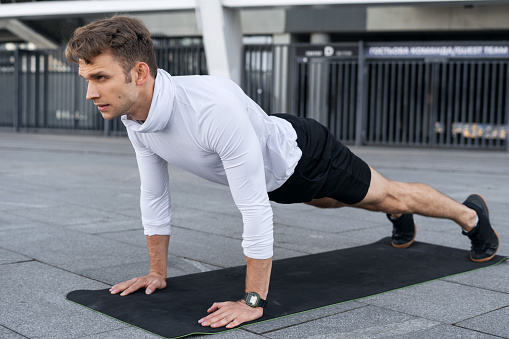
Execution:
Stand in a supine position with the upper limbs stretched out, shoulder width apart, palms facing forward, lower limbs touching the mat with the toes. The entire torso is stretched out and rigid like a board. Do not lower the buttocks too far or push them above the level of the back.
Slowly lower the arms down with a breath until the chest touches the mat.
Then, with an exhale, begin to push back up to the original position. Exhale fully after the movement is complete.
Variations:
If we put the arms closer together, we strengthen the triceps more. If further apart, we put more stress on the shoulders and chest.
The lower limbs can be placed on a raised mat, which will transfer the tension more to the shoulders and upper chest.
If our arms are higher than our legs, we strengthen the lower chest or back and shoulder muscles more.
If we can't do that, we can do push-ups leaning on our knees. Of course, a soft mat is then a must.
The higher our upper body is compared to our lower limbs, the easier it is to perform this exercise. At the same time, however, its effect on the muscles changes.
If this is not enough, we can make the exercise more difficult. Just place both hands, but separately, on raised mats of the same height. These can also be books of the same thickness.
Then we can lower the chest down to below the level of the mat. This will cause a greater range of motion and therefore the need to exert more force to move backwards.
Of course, push-ups can also be performed on one arm. In this case, if you are starting out, it is a good idea to perform the exercise with the upper torso raised and to lower the upper body as your fitness improves.
Triceps lifts
Muscle exercised: triceps
This is an exercise in which we use the weight of our own body to exercise the triceps. That is, the muscles of the upper limbs.
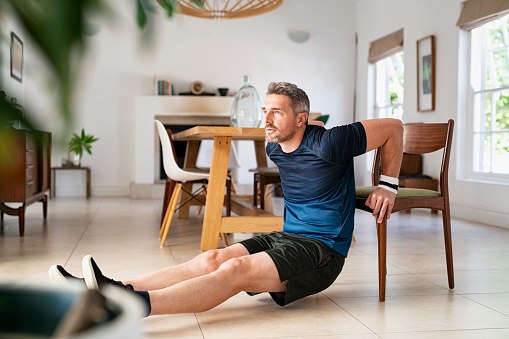
Execution:
Hands shoulder width apart, resting on an elevated mat behind your back.
At home this can be the edge of a chair or bed.
The palms face forward, with the feet resting on the floor with the heels. The height of the mat on which the hands rest should not be below knee level.
Slowly lower the buttocks towards the ground by bending the upper limbs at the elbows. However, only until the arms are horizontal with the ground.
The forearms remain perpendicular to the mat.
Once this position is reached, come back down. This will be the hardest part of the exercise.
Variations:
The smaller the height difference between the feet and hands, the more difficult the exercise.
In this case, we can place the feet with the heels on the opposite mat at the same or lesser height.
Similarly, the closer the upper limbs are to each other, the more difficult the exercise will be.
Shrugs on the trapeze
Areas exercised: back muscles, biceps, forearms
This exercise belongs to the pulling exercises.
It develops the upper body, especially the back muscles.
The load, in this case your own body, is pulled upwards against gravity using your arms.
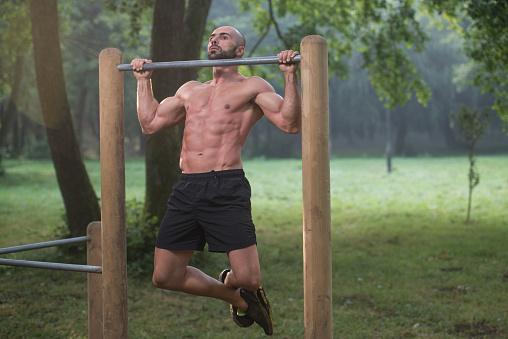
Execution:
Simply hang from a trapeze bar with your hands shoulder-width apart.
Lower yourself all the way down, but not so far that your entire weight hangs on your hands.
Start pulling yourself up to the trapeze until your chin is just above it.
Then lower down slowly and controlled. Repeat.
Inhale downwards and exhale fully when the chin is above the bar.
Variations:
If you can't handle the exercise, you can bend your legs at the knees as you pull up.
We can also use a mat behind our back to support our legs and use our toes to push up.
If we want to put more weight on our biceps, we can hang from the trapeze bar with our palms facing up.
An alternative for exercising at home is hanging on the door. Of course, it must be without glass and secured against closing.
Here, however, the exercise is more challenging. We cannot bend our legs at the knees on the door and thus make the exercise easier. We are also hindered by the fact that we touch them with our thighs.
In this case, however, we cannot exercise hanging from the stirrups. For this, vertical pull-ups are a useful alternative at home.
If we want a heavier load, we can wait a while in the bar position. We can hold for two or three seconds and then start lowering down in a controlled and slow manner.
Military press
Translated, this means military press.
Muscle groups exercised: shoulders, triceps
Another pressing exercise.
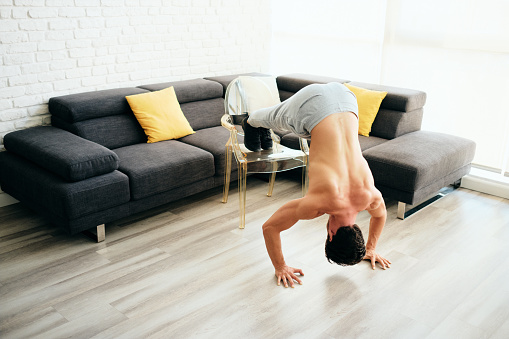
Execution:
Stand with your heels together. Bend over and rest your palms on the mat at a distance of five lengths from the tops of your feet.
Hands shoulder-width apart.
The feet are on tiptoes. There should be a 90 degree angle between the torso and the feet.
The lower limbs should be extended throughout the exercise.
Slowly lower yourself down by bending your arms at the elbows.
Once in position with your face parallel to the mat, push your arms back up.
Variations:
If we want to add more, we can place our hands on the raised mat at the same height, one at a time. This increases the range of motion because we can lower our arms lower.
For example, we can use books to do this.
We can also place the feet or both upper and lower limbs on the raised mat at the same time.
If you want to make the exercise a little easier, put your palms more than five lengths in front of you. But this will already start to work other muscles that will help you.
Vertical pull-ups
Muscle groups exercised: biceps, back muscles, shoulders
These exercises are among the stretching exercises.
When it comes to exercises with your own body weight, this is probably the best exercise for the biceps muscles.

Execution:
In home conditions, an open door will suffice.
Stand facing the edge of the door and hold onto the door handle. Each hand on one side. You can underhand, overhand or sideways.
We hold the door between our legs and grip it with our hands, which will be approximately level with the handle.
The legs bent at the knees will be at right angles with the back extended.
With our feet firmly planted in the ground, we will begin to slowly lower ourselves down until our arms are extended.
When we reach the maximum, we will pull our arms back until our chest touches the edge of the door.
Thighs are still at right angles with your back extended.
Variations:
This exercise can, of course, be done outdoors. All we need is a solid horizontal bar, railing or edge to hold on to.
If you want to extend your grip, wrap a towel or rope around the handle. Then hold on to both ends.
We can make the exercise easier by moving our feet backwards, toes to the edge of the door.
The opposite effect is again produced by moving the feet forward.
We can also make the exercise more difficult by reducing the grip of the hands. For example, if we are standing on a raised platform.
We will have to exert more force if we practise with one hand on each side separately. In this case, a sign or lamp will also help us.
Hip extension
Areas to be exercised: buttocks, back of thighs, lower back
A simple and practical exercise.
Very effective especially for the back of the thighs.
Execution:
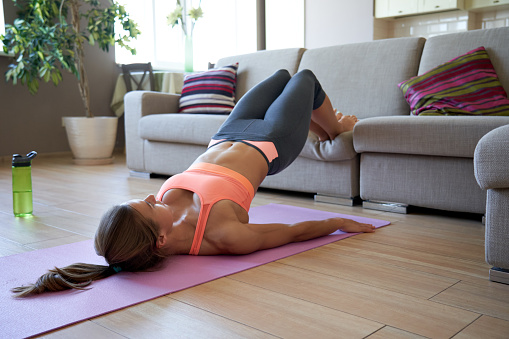
Lie on your back. Place your heels on a raised mat. This can be a stool.
It should be at such a height that the shins are parallel to the floor and at right angles to the thighs.
Slowly begin to lift your hips and buttocks.
Once you have reached a position where your thighs are flush with your buttocks, stay in this position for two seconds.
Then begin to slowly descend to the original position.
During the exercise, consciously contract the buttocks and thighs.
Variations:
If we want to make the exercise more difficult, we can exercise each leg separately.
In outdoor conditions, for example, a park bench can be used.
Squats on one leg
Areas exercised: quadriceps, hamstrings, glutes, lower back
If we say that this is one of the best exercises for developing almost all components of lower limb fitness, we will not be far from the truth.
It also helps to improve coordination and balance.
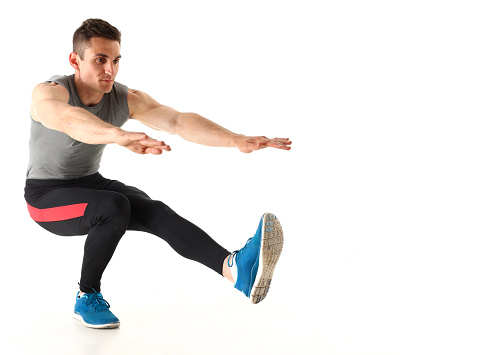
Execution:
Standing on one leg.
On the side of the standing leg, rest your hand on the back of a chair, for example. Preferably at waist level.
Slowly lower yourself down, but the back of the chair is only for balance.
Keep the other leg extended in the air.
When the thigh of the standing leg is horizontal with the ground, begin to slowly raise to the original position.
The knee must not extend in front of the toe.
All the time we do not try to help ourselves with the back of the stool.
When we are up, we continue to repeat on the same lower leg.
Variations:
To make the exercise easier, we can alternate legs after each repetition. Then it is good to stand between two stools or other supports.
The squats can also be performed from a seated position, so that in the down position we have a mat under the buttocks that is high enough so that the thigh is horizontal with the ground.
In home conditions we use a stool.
If we need to add, we perform the exercise without support with our arms outstretched.
Alternatively, we stand on an elevated mat to go deeper.
If neither is standing, grasp the free leg behind the back so that the heel rests on the buttocks.
If we are complete beginners, we perform squats on both lower legs.
With support, later without support and also from a seated position.
As we get better, we can stretch our arms and if we lift or lock them, the exercise becomes more difficult.
Bulgarian squats
Areas exercised: quadriceps, hamstrings, gluteal muscles
When performed correctly, it is as effective as the previous exercise. It can serve as a good preparation for single leg squats.
It can also be practiced unilaterally, i.e. on each leg separately.
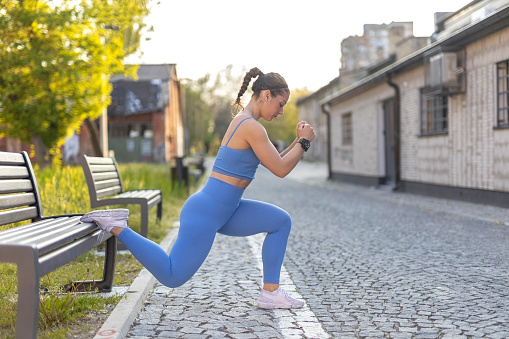
Execution:
Stand in front of an elevated mat that is about half a metre behind you. At home this can be a stool. Ideally at knee height.
We can put one foot on it with the toe or the instep. For more comfort, we can put a cushion underneath.
The other leg stays in place.
Slowly lower down until the thigh of the front leg is horizontal with the floor.
Then return to the original position.
This is a good way to exercise both lower limbs. However, the strength must be concentrated in the front leg.
After completing one set, switch legs.
If we don't hold on to anything, we are also practicing balance well.
Variations:
To make the exercise more difficult, wear a weight on your back, such as a book bag.
Sometimes it is enough to just stand up, i.e. raise your arms above your head.
Lunges
Areas exercised: calves
One of several exercises for the calves.
However, this one is not equipment-intensive and can be practiced virtually anytime, anywhere.
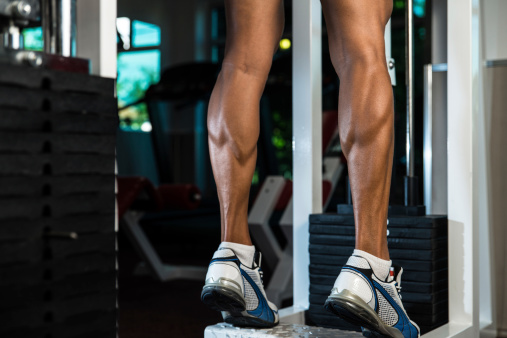
Execution:
Stand with the toes of your feet on the edge of a raised mat.
At home, this can be a step or a higher threshold, or a thick book.
Keep your knees slightly bent, but really only slightly.
The heels are in the air.
Slowly lower them as far down as possible. Stay in this position for about a second and push up on your toes as high as you can. Wait in this position again for about a second.
Do this for several repetitions.
During the exercise, you can hold onto the wall with your hands to keep your balance. Try not to help yourself.
Variations:
If we want to make the exercise more difficult, we can do it unilaterally, i.e. on each leg separately.
If we are exercising the outer calf muscle, our toes will be towards each other and our heels away from each other.
If we focus on the inner calf muscle, the heels will be facing towards each other and the toes away from each other.
Round
Areas exercised: straight abdominals, oblique abdominals, intercostals
To exercise the whole body, we have one more exercise for the abdomen.
One of the best exercises for comprehensive development of the abdominal muscles.
It is not a round as such. The name is derived from the activity we perform while performing it.
It's like pedaling a bike, but in the supine position with the torso pulled to the side.
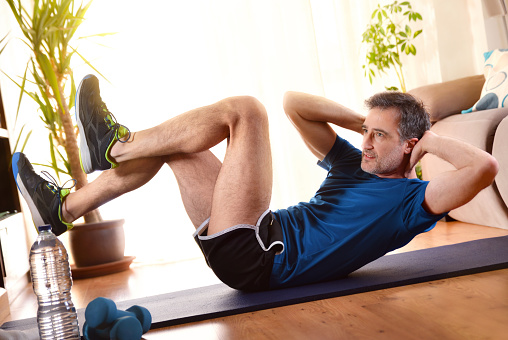
Execution:
Lying on your back, legs extended. In this position, lift your legs slightly off the mat so that they do not touch the ground.
Place the hands with the palms behind the head.
Slowly pull the knee of the right leg towards the chest and at the same time bring the elbow of the left hand towards the chest.
Pull the torso up slightly so that the movement is not performed with the hands.
Touch the elbow to the knee and begin to return to the original position.
Repeat with the opposite leg and elbow.
Do this for several repetitions.
Variations
If you want to make the exercise more difficult, try to keep your torso slightly raised above the mat at all times, in addition to your legs. This means that you only touch the ground with your buttocks.
In the table below, we show a simple example of a Tabata exercise
| Exercises | Exercise length | Length of break |
| Shrugs on the trapeze | 20 seconds | 10 seconds |
| Push-ups | 20 seconds | 10 seconds |
| Triceps lifts | 20 seconds | 10 seconds |
| Hip extensions | 20 seconds | 10 seconds |
| Squats | 20 seconds | 10 seconds |
| Military press | 20 seconds | 10 seconds |
| Vertical pull-ups | 20 seconds | 10 seconds |
| Cycling | 20 seconds | End of series |
This is how we exercise the whole body.
When the series is over, we can continue with another round after a one minute or longer break.
We can perform a maximum of 4 repetitions. More than that is already counterproductive. Fatigue sets in and performance decreases, and so does the correct execution of the exercises.
There is a risk of injury.
This system of high-intensity interval training is not for beginners.
However, anyone can try it.
Just change the ratio of exercise and rest phases.
For beginners, it is better to start with an interval of, for example, 15 seconds of exercise and 30 seconds of rest. Each of us can, of course, adjust this according to our own level of fitness. Later, when we improve our own physical parameters, we can lengthen the exercise time and shorten the rest period.
These few exercises are just a small demonstration and a guide on how to exercise with your own body weight.
They can also be done at home.
There are a variety of exercises and many of them can certainly be invented.
It is up to our imagination.
If you want to enrich your workout, you can read the article about what a plank is.
Interesting resources










